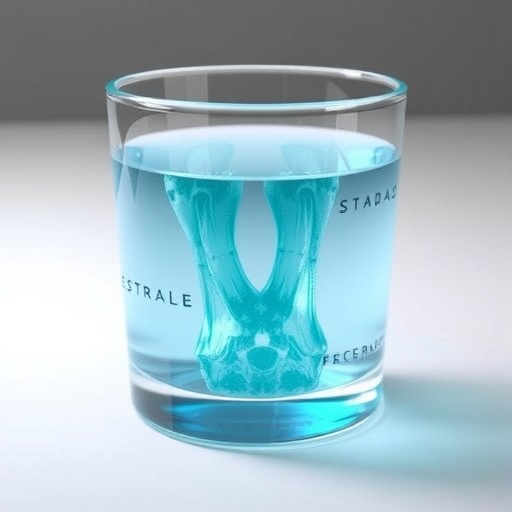In a groundbreaking advancement at the intersection of materials science and regenerative medicine, researchers have engineered a novel 3D-printable bio-active glass designed to serve as a bone substitute. This ingenuity stems from the unexpected parallels between bone and glass—two materials traditionally viewed as fundamentally different, yet both capable of bearing significant mechanical loads due to their intricate crystalline structures. Published in ACS Nano, this innovative work showcases a bio-engineered material that promises to transform orthopedic treatments and tissue engineering by offering shape-customizable, biocompatible scaffolds conducive to sustained bone regeneration.
Bone tissue, a complex composite of collagen and minerals, has evolved to withstand substantial compressive forces, although it performs less effectively under tensile stress. Glass, predominantly composed of silica, shares a similar mechanical profile, which makes it an intriguing candidate for biomimetic applications. Historically, however, using glass as a framework for bone regeneration has been constrained by manufacturing limitations. Conventional 3D-printable glass formulations require plasticizing additives, often toxic, or processing temperatures exceeding 2,000 degrees Fahrenheit (about 1,100 degrees Celsius), both of which hinder widespread medical application. This novel bio-active glass overcomes these challenges, positioning itself as a scalable and safer alternative.
Led by Jianru Xiao, Tao Chen, and Huanan Wang, the team employed a groundbreaking colloidal chemistry approach to create a printable hydrogel comprised of oppositely charged silica particles integrated with calcium and phosphate ions. These ions are well documented for their osteoinductive properties, promoting bone cell differentiation and proliferation. The resulting bioglass precursor exhibits self-healing characteristics intrinsic to colloidal hydrogels, facilitating seamless 3D printing without the necessity for plasticizers or extreme thermal conditions. This “green” manufacturing process culminates in a sintering phase at a significantly lower furnace temperature of 1,300 degrees Fahrenheit (700 degrees Celsius), optimizing energy efficiency and preserving bioactivity.
In vivo assessments underscored the material’s therapeutic potential. When implanted into rabbit models with cranial defects, the bio-active glass scaffold outperformed plain silica glass in fostering bone cell colonization and growth. Although a commercially available dental bone substitute initiated faster bone formation initially, it lacked the sustained biological activity demonstrated by the bio-glass. After eight weeks, the bio-active glass scaffold maintained robust bone cell populations, suggesting its superior capacity to support long-term tissue regeneration. These findings elucidate how the integration of bioactive ions within the glass matrix provides a microenvironment conducive to osteogenesis over prolonged periods.
A pivotal advantage of this bioglass lies in its tailorability. The 3D-printing process allows for the fabrication of patient-specific implants, precisely matching complex bone geometries lost to trauma, disease, or congenital defects. The ability to customize implant shapes not only improves anatomical integration but also reduces surgical times and post-operative complications. Moreover, the inherent porosity achievable through this hydrogel printing technique facilitates vascularization, a critical factor for the survival and functionality of regenerated tissues.
From a materials engineering perspective, the colloidal hydrogel demonstrates remarkable rheological properties. Its shear-thinning and self-healing behavior enable smooth extrusion through printing nozzles and immediate structural recovery post-deposition, ensuring the fidelity of printed architectures. This self-healing property also implies potential for injectable formulations that can conform in situ, expanding clinical versatility beyond rigid scaffolds. Furthermore, the complete inorganic composition eliminates the need for polymeric carriers, reducing the risk of inflammatory responses traditionally associated with synthetic biomaterials.
Beyond orthopedics, this innovation opens vistas for broader applications spanning craniofacial reconstruction, dental implants, and even load-bearing components in biohybrid devices. The synthesis approach fundamentally shifts the paradigm of biomaterial manufacturing, highlighting how careful molecular design and process optimization can reconcile mechanical strength, biofunctionality, and environmental sustainability. The bio-glass system exemplifies a “green” route to advanced prosthetics that harmonize with the body’s natural healing processes while minimizing ecological footprints.
While this research marks significant progress, the translation from animal models to human clinical use necessitates extensive validation. Future studies will need to explore long-term biocompatibility, integration with host vasculature, and potential immune responses. Additionally, integrating growth factors or stem cells within the bio-glass matrix could enhance regenerative outcomes. The modularity of the colloidal hydrogel system allows for such functionalization, potentially ushering in a new class of multifunctional biomaterials tailored for diverse therapeutic needs.
Notably, this work tackles one of regenerative medicine’s enduring challenges: reconciling the structural demands of load-bearing implants with the biological complexities of tissue integration. By leveraging the unique properties of silica-based frameworks combined with osteogenic ions, the researchers provide an elegant solution balancing mechanical integrity and bioactivity. The relatively low-temperature sintering not only preserves the functional ions but also facilitates compatibility with heat-sensitive biological agents, expanding the scope for composite constructs.
In conclusion, the rational design of purely inorganic self-healing colloidal hydrogels represents a transformative stride toward next-generation bone substitutes. This bio-active glass scaffold redefines the concept of 3D-printed biomaterials, marrying the advantages of glass mechanics with tailored biofunctionality without relying on toxic additives or energy-intensive processing. As regenerative medicine converges with green chemistry and advanced manufacturing, innovations such as this pave the way for safer, more effective, and environmentally conscious medical devices.
Subject of Research: Development of a 3D-printable bio-active glass hydrogel scaffold for bone substitution and tissue engineering.
Article Title: “Rational Design of Purely Inorganic Self-Healing Colloidal Hydrogels To Enable “Green” 3D Printing of Bioglass-Based Bone Substitutes”
News Publication Date: 3-Sep-2025
Web References: http://dx.doi.org/10.1021/acsnano.5c06377
Image Credits: Adapted from ACS Nano 2025, DOI:10.1021/acsnano.5c06377
Keywords
Chemistry, Health and medicine, Tissue engineering




